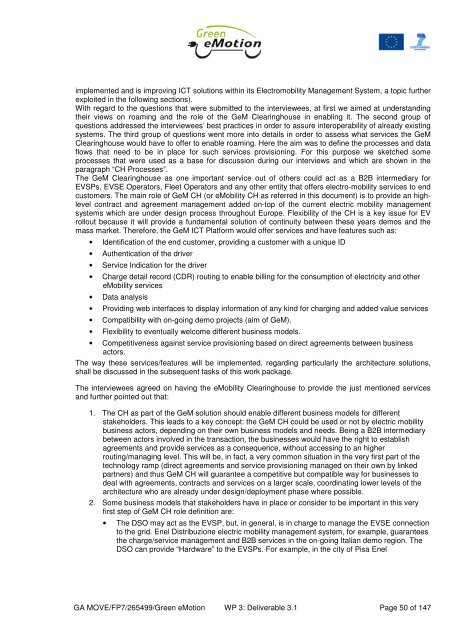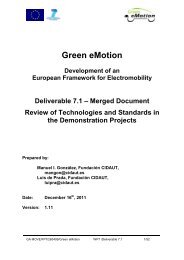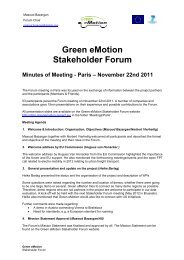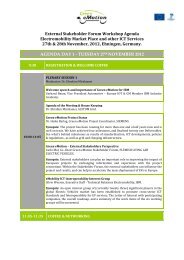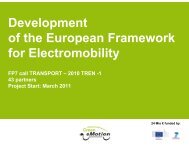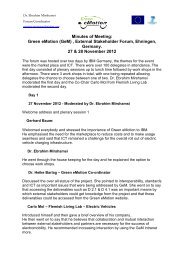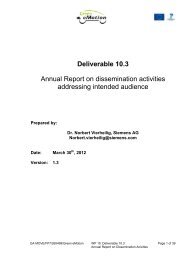Deliverable 3.1 Business Analysis - Green eMotion Project
Deliverable 3.1 Business Analysis - Green eMotion Project
Deliverable 3.1 Business Analysis - Green eMotion Project
Create successful ePaper yourself
Turn your PDF publications into a flip-book with our unique Google optimized e-Paper software.
implemented and is improving ICT solutions within its Electromobility Management System, a topic further<br />
exploited in the following sections).<br />
With regard to the questions that were submitted to the interviewees, at first we aimed at understanding<br />
their views on roaming and the role of the GeM Clearinghouse in enabling it. The second group of<br />
questions addressed the interviewees’ best practices in order to assure interoperability of already existing<br />
systems. The third group of questions went more into details in order to assess what services the GeM<br />
Clearinghouse would have to offer to enable roaming. Here the aim was to define the processes and data<br />
flows that need to be in place for such services provisioning. For this purpose we sketched some<br />
processes that were used as a base for discussion during our interviews and which are shown in the<br />
paragraph “CH Processes”.<br />
The GeM Clearinghouse as one important service out of others could act as a B2B intermediary for<br />
EVSPs, EVSE Operators, Fleet Operators and any other entity that offers electro-mobility services to end<br />
customers. The main role of GeM CH (or eMobility CH as referred in this document) is to provide an highlevel<br />
contract and agreement management added on-top of the current electric mobility management<br />
systems which are under design process throughout Europe. Flexibility of the CH is a key issue for EV<br />
rollout because it will provide a fundamental solution of continuity between these years demos and the<br />
mass market. Therefore, the GeM ICT Platform would offer services and have features such as:<br />
• Identification of the end customer, providing a customer with a unique ID<br />
• Authentication of the driver<br />
• Service Indication for the driver<br />
• Charge detail record (CDR) routing to enable billing for the consumption of electricity and other<br />
eMobility services<br />
• Data analysis<br />
• Providing web interfaces to display information of any kind for charging and added value services<br />
• Compatibility with on-going demo projects (aim of GeM).<br />
• Flexibility to eventually welcome different business models.<br />
• Competitiveness against service provisioning based on direct agreements between business<br />
actors.<br />
The way these services/features will be implemented, regarding particularly the architecture solutions,<br />
shall be discussed in the subsequent tasks of this work package.<br />
The interviewees agreed on having the eMobility Clearinghouse to provide the just mentioned services<br />
and further pointed out that:<br />
1. The CH as part of the GeM solution should enable different business models for different<br />
stakeholders. This leads to a key concept: the GeM CH could be used or not by electric mobility<br />
business actors, depending on their own business models and needs. Being a B2B intermediary<br />
between actors involved in the transaction, the businesses would have the right to establish<br />
agreements and provide services as a consequence, without accessing to an higher<br />
routing/managing level. This will be, in fact, a very common situation in the very first part of the<br />
technology ramp (direct agreements and service provisioning managed on their own by linked<br />
partners) and thus GeM CH will guarantee a competitive but compatible way for businesses to<br />
deal with agreements, contracts and services on a larger scale, coordinating lower levels of the<br />
architecture who are already under design/deployment phase where possible.<br />
2. Some business models that stakeholders have in place or consider to be important in this very<br />
first step of GeM CH role definition are:<br />
• The DSO may act as the EVSP, but, in general, is in charge to manage the EVSE connection<br />
to the grid. Enel Distribuzione electric mobility management system, for example, guarantees<br />
the charge/service management and B2B services in the on-going Italian demo region. The<br />
DSO can provide “Hardware” to the EVSPs. For example, in the city of Pisa Enel<br />
GA MOVE/FP7/265499/<strong>Green</strong> <strong>eMotion</strong> WP 3: <strong>Deliverable</strong> <strong>3.1</strong> Page 50 of 147


